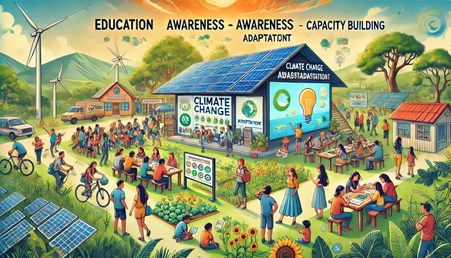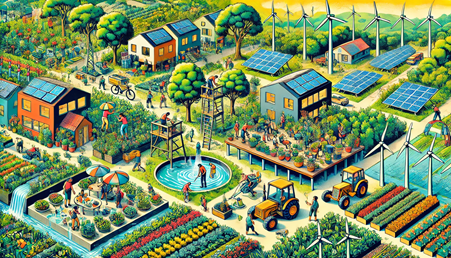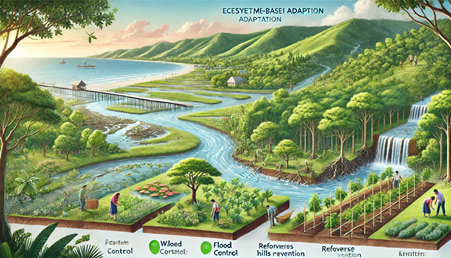What strategies are most effective in helping communities adapt to climate change?

What strategies are most effective in helping communities adapt to climate change?
by Nathaniel 02:36pm Jan 08, 2025

What strategies are most effective in helping communities adapt to climate change?
Communities around the world are facing the growing threat of climate change, and adapting to its impacts is essential for resilience and long-term sustainability. Effective strategies for adaptation address both immediate and future climate-related risks, focusing on mitigating the effects of climate change while also enhancing social, environmental, and economic resilience. Below are several key strategies that have proven effective in helping communities adapt to climate change:
1. Climate-Resilient Infrastructure
Strategy:Building and retrofitting infrastructure to withstand extreme weather events, rising sea levels, and temperature fluctuations is crucial for community adaptation. This includes flood defenses, resilient transportation networks, and energy systems.
Examples:
Flood Barriers and Coastal Defenses: Cities like New York have invested in coastal protections such as seawalls and flood barriers to mitigate storm surges and rising sea levels.
Resilient Buildings:Retrofitting homes and buildings to withstand extreme heat, heavy rains,or floods through measures such as elevated structures, hurricane-proof windows, and heat-resistant materials.
Effectiveness:These measures help protect physical assets, reduce damage from extreme weather events, and ensure that vital services can continue during climate-related disruptions.
2. Sustainable Water Management
Strategy:Managing water resources to address changing precipitation patterns,droughts, and flooding is a key adaptation strategy. This includes the use of efficient irrigation systems, rainwater harvesting, and improving water storage and drainage systems.
Examples:
Rainwater Harvesting:Cities like Cape Town have implemented rainwater harvesting systems to secure water supplies during droughts.
Sustainable Drainage Systems (SuDS): The city of London has introduced green infrastructure like rain gardens and permeable pavements to manage stormwater runoff and reduce the risk of flooding.
Effectiveness:By improving water management, communities can ensure a reliable water supply during droughts, reduce flood risks, and manage changing rainfall patterns.
3. Climate-Smart Agriculture
Strategy:Climate-smart agricultural practices help farmers adapt to changing weather conditions while promoting sustainable food production. This includes crop diversification, water-efficient irrigation, and the use of drought-resistant crops.
Examples:
Crop Diversification and Agroforestry: In regions like Sub-Saharan Africa, farmers have adopted drought-tolerant crops and integrated tree planting to protect soils and improve yields.
Precision Agriculture: Using technology like sensors and data analytics,farmers can optimize water usage, fertilizer application, and pest control to make agriculture more resilient to climate variability.
Effectiveness:Climate-smart agriculture ensures that farmers are able to maintain food security and livelihoods in the face of changing climate conditions, such as increased droughts or floods.
4. Ecosystem-Based Adaptation (EbA)
Strategy:This approach involves the conservation and restoration of ecosystems to provide natural protection against climate impacts. Healthy ecosystems,such as wetlands, forests, and mangroves, can protect communities from floods, storm surges, and heatwaves.
Examples:
Mangrove Restoration:In countries like Vietnam, mangrove restoration projects have helped protect coastal communities from storm surges and provide sustainable livelihoods through eco-tourism and fisheries.
Urban Green Spaces:Cities like Singapore integrate green spaces, including parks and green roofs, to reduce urban heat island effects and improve air quality.
Effectiveness:Ecosystem-based adaptation leverages the natural environment to buffer communities from climate impacts, while also providing additional benefits such as improved biodiversity, cleaner air, and enhanced recreational spaces.
5. Community-Based Adaptation (CBA)
Strategy:CBA involves local communities in the planning and implementation of adaptation strategies. This approach emphasizes local knowledge and empowers vulnerable populations to take an active role in their adaptation to climate change.
Examples:
Participatory Planning: In Bangladesh, communities have developed local climate adaptation plans based on their specific risks, such as flooding or cyclones, and have worked with NGOs to implement resilience measures.
Early Warning Systems: In Kenya, community-led early warning systems have been established to alert local populations about extreme weather events, such as floods or droughts, allowing them to take precautionary actions.
Effectiveness:CBA ensures that adaptation strategies are context-specific, culturally relevant, and tailored to the needs of vulnerable populations, enhancing community resilience and ownership of the process.
6. Disaster Risk Reduction and Preparedness
Strategy:Strengthening disaster preparedness and response systems helps communities cope with the immediate impacts of climate-related disasters. This includes the development of early warning systems, evacuation plans, and emergency response capabilities.
Examples:
Flood Early Warning Systems: Countries like Thailand have implemented early warning systems to alert communities about impending floods,enabling timely evacuation and damage reduction.
Community Disaster Response Plans: In Philippines, local governments have developed disaster response plans that include the training of volunteers and the stockpiling of supplies to ensure quick recovery after natural disasters.
Effectiveness:Disaster risk reduction strategies save lives and reduce the economic cost of climate-related disasters by enabling quicker responses and minimizing damages.
7. Social Protection and Livelihood Diversification
Strategy:Providing social safety nets, such as insurance and cash transfer programs, can help vulnerable communities recover from the impacts of climate change. Livelihood diversification also helps communities become more resilient by reducing dependence on single sectors, like agriculture, that may be heavily impacted by climate change.
Examples:
Microinsurance: In India, crop insurance schemes have been implemented to protect farmers against the financial loss caused by extreme weather events like floods and droughts.
Livelihood Diversification Programs: In Pacific Island nations, programs have been introduced to diversify livelihoods away from climate-sensitive sectors, such as fishing, to more resilient industries like eco-tourism and small-scale manufacturing.
Effectiveness:Social protection programs provide a safety net for those most affected by climate change, allowing them to recover more quickly. Livelihood diversification helps communities reduce their vulnerability to climate risks.
8. Education, Awareness, and Capacity Building
Strategy:Building the capacity of individuals, communities, and local governments to understand and respond to climate risks is a key strategy. This involves raising awareness about climate change impacts and fostering skills that enable communities to adapt.
Examples:
Climate Change Education: Programs in Costa Rica and Thailand teach communities about sustainable farming techniques, water conservation, and climate change risks, equipping them with the knowledge to adapt to climate challenges.
Training Local Leaders: In Nepal, local government officials are trained to implement climate adaptation plans and work with communities to ensure their needs are met.
Effectiveness:Education and capacity-building empower individuals and communities to take proactive steps toward adaptation, ensuring that climate resilience becomes an integral part of local development planning.
9. Policy and Governance Reform
Strategy:Effective governance and strong policy frameworks are crucial for driving adaptation at the national, regional, and local levels. Governments can create climate action plans, provide funding for adaptation projects, and ensure that adaptation is integrated into broader development policies.
Examples:
National Adaptation Plans (NAPs): Countries like Mexico and Vietnam have developed comprehensive adaptation plans that guide national, regional, and local climate responses, with a focus on equity and inclusion.
Climate-Resilient Development: In Colombia, the government has integrated climate resilience into national development planning, with policies that promote sustainable agriculture, water management, and urban resilience.
Effectiveness:Policy and governance reform ensures that adaptation is prioritized at all levels of government and integrated into broader national and local development agendas.
Conclusion
Adapting to climate change requires a multi-faceted, integrated approach that combines technological, ecological, and social strategies. Effective adaptation involves building resilient infrastructure, managing resources sustainably, empowering communities, and ensuring that climate adaptation is a central element of governance. By adopting these strategies, communities can better cope with the challenges posed by climate change, minimize risks, and build long-term resilience.






